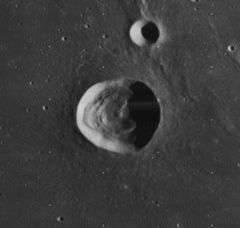
Hermann (crater)
Hermann is a small lunar crater that is located in the western Oceanus Procellarum, just over one crater diameter to the south of the Moon's equator. It is a solitary crater with only a few tiny craterlets and some low wrinkle ridges nearby.
The interior floor of this crater has been flooded with lava, leaving a dark surface with the same albedo as the surrounding lunar mare. Only a low, nearly circular rim projects above the surface, which is not significantly eroded. The rim has a slight outward bulge on the western rim.
Satellite craters
By convention these features are identified on lunar maps by placing the letter on the side of the crater midpoint that is closest to Hermann.
References
Hermann
Hermann or Herrmann may refer to:
- Hermann AVA, Missouri wine region
See also

Hermann Huppen
Hermann Huppen (born 17 July 1938) is a Belgian comic book artist. He is better known under his pen-name Hermann. He is most famous for his post-apocalyptic comic Jeremiah which was made into a television series.
Biography
Hermann was born in 1938 in Bévercé (now a part of Malmedy) in Liège Province. After studying to become a furniture maker and working as interior architect, Hermann made his debut as comic book artist in 1964 in the Franco-Belgian comics magazine Spirou with a four page story. Greg noticed his talent and offered him to work for his studio. In 1966, he began illustrating the Bernard Prince series written by Greg, published in Tintin magazine. In 1969, also in collaboration with Greg, he began the western series Comanche. This appeared at the same time as other western series such as Blueberry.
Hermann began writing his own stories in 1977, starting the post-apocalyptic Jeremiah series, which is still produced today. In the same period, he also made three albums of Nick, inspired by Little Nemo in Slumberland, for Spirou. In 1983 he began a new series, Les Tours de Bois-Maury, which is set in the Middle Ages and is less focused on action than his other works.

Hermann station (Missouri)
Hermann is an Amtrak train station in Hermann, Missouri, United States. Hermann became a permanent stop on September 28, 1991 when the Mules and Ann Rutledge began stopping there. Trains had previously stopped only during Hermann's annual Maifest and Octoberfest.
A rebuilt station was approved for construction in 2006 and opened on September 12, 2014. The one story depot features a random rubble stone veneer base, walls clad in traditional clapboard siding and a hipped roof. The waiting room is trimmed in bead board wainscoting, and there are also accessible restrooms. Displays trace the area’s transportation history, with a focus on the Missouri River, railroads and roadways. Funding for the project came through the Federal Highway Administration's Transportation Enhancements program, the city of Hermann and the Dierberg Educational Foundation, a local non-profit organization that supports projects to preserve the region’s cultural heritage.
References
External links
Crater
Crater may refer to:
In landforms:
Other:

Crater (Aden)
Crater (/ˈkreɪtər/; Arabic: كريتر, [ˈkɾeːtəɾ]), also Kraytar, is a district of the Aden Governorate, Yemen. Its official name is Seera (Arabic: صيرة Ṣīrah). It is situated in a crater of an ancient volcano which forms the Shamsan Mountains. In 1991, the population was 70,319. As of 2003, the district had a population of 76,723 people.
In the closing days of British rule in 1967, Crater District became the focus of the Aden Emergency, sometimes called the last imperial war. After a mutiny of hundreds of soldiers in the South Arabian Federation Army on 20 June, all British forces withdrew from the Crater. The Crater was occupied by Arab fighters while British forces blocked off its two main entrances. In July, a British infantry battalion, led by Lt. Col. Colin Mitchell of the Argyll & Sutherland Highlanders, entered the Crater and managed to occupy the entire district overnight with no casualties. Nevertheless, deadly guerrilla attacks soon resumed, with the British leaving Aden by the end of November 1967, earlier than had been planned by British Prime Minister Harold Wilson and without an agreement on the succeeding governance.
Crater (Chinese astronomy)
According to traditional Chinese uranography, the modern constellation Crater is located within the southern quadrant of the sky, which is symbolized as the Vermilion Bird of the South (南方朱雀, Nán Fāng Zhū Què).
The name of the western constellation in modern Chinese is 巨爵座 (jù jué zuò), meaning "the huge wine holder constellation".
Stars
The map of Chinese constellation in constellation Crater area consists of :
See also
References
External links
Podcasts:

